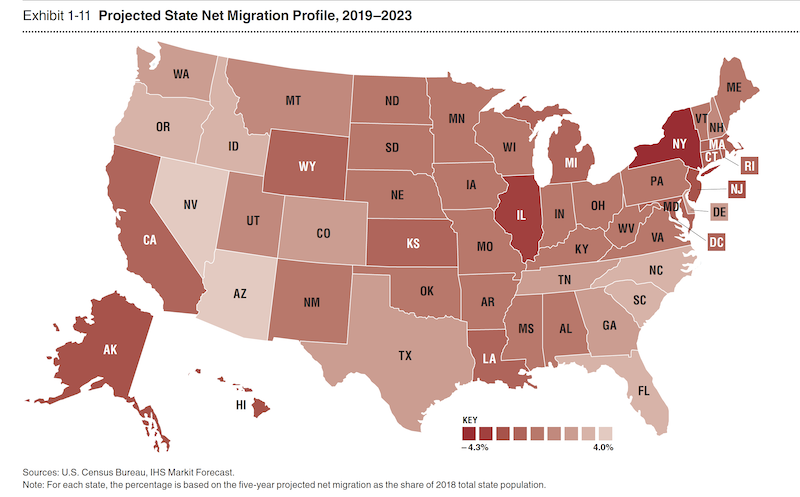The current record-setting expansion in the U.S. economy and its real estate sector, which dates back to the start of this decade, should continue through 2021, but at a moderated pace.
That’s the consensus prediction, based on a recent survey of 41 economists and analysts at 32 leading real estate organizations. Those experts’ opinions about all things real estate—from transaction volumes and pricing to returns on investment and housing development—form the basis of the Urban Land Institute’s Real Estate Economic Forecast, which ULI released last week.
The trends that are likely to drive the pace of that growth are identified in Emerging Trends in Real Estate 2020, which ULI and PwC, the accounting and research firm, released last month. That 92-page report is based on survey responses from 1,450 people working for various real estate-related businesses (nearly 28% of whom are private property owners or developers), and 750 individuals whom the report’s researchers interviewed personally.
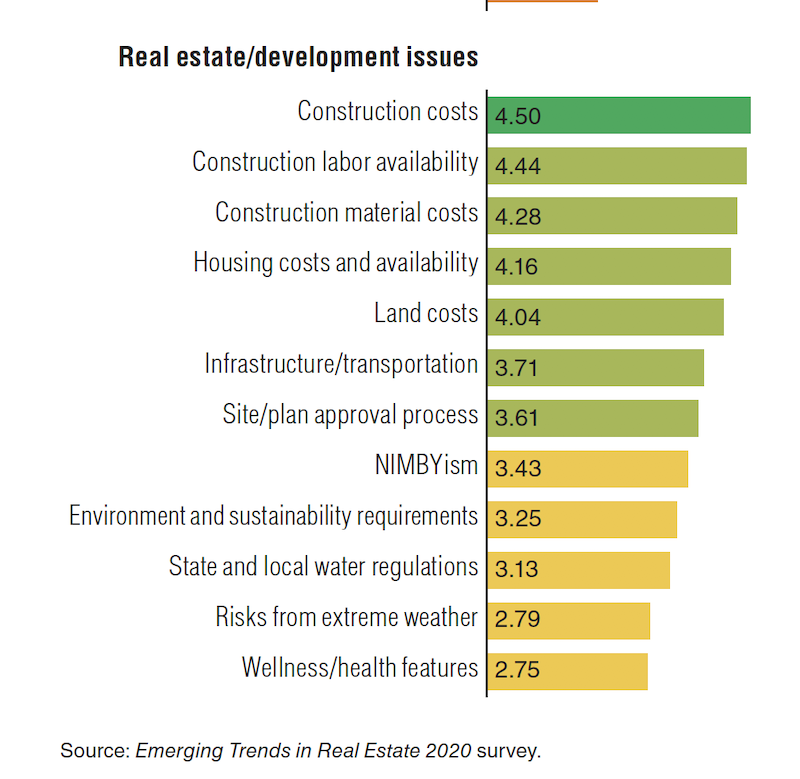
Rising construction costs lead the areas of concern that could stymie real estate growth.
Austin ranks first out of 80 metros in the U.S. for having the greatest potential for real estate for 2020, followed by Raleigh-Durham, N.C., Nashville, Charlotte, and Boston. The Emerging Trends report assesses which markets are worth watching by six criteria that include population projections, homebuilding prospects, investor demand, and redevelopment opportunities.
Manhattan and Chicago will continue to lead the pack as capital magnets for real estate investment. Philadelphia and Long Island, N.Y., are among the metros with sustained track records for capital flow and transaction volume. And Jacksonville, Fla., Salt Lake City, and Columbus, Ohio, are deemed “treasures ripe for discovery.”
The report makes “buy-hold-sell” recommendations within metros for different building types. For example, nearly three-fifths of respondents gave Oakland/East Bay in California a “buy” recommendation for office properties. Orlando ranked highest for multifamily properties, Nashville for retail, Charleston, S.C., for hotels.
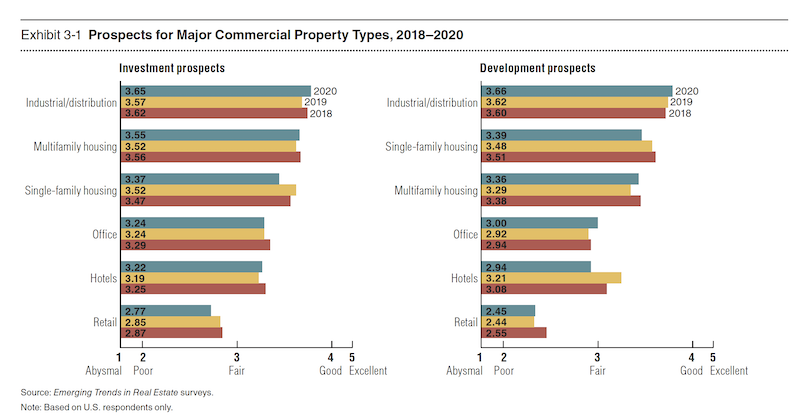
Warehouse distribution, in an era of online shopping, continues to be seen as fertlle for future development.
Nationally, industrial buildings, such as warehouses, have the greatest prospects among commercial real estate property types for 2020 in terms of their return performance and growth outlook, followed by multi- and single-family housing.
This report, though, isn’t all upbeat. Among the trends it spots is an “extended downshifting” in the economy, which is likely to have implications for commercial property demand “in the decades ahead.” The report warns against “a surfeit of capital desperately seeking placement,” which could create a real estate bubble. And the repot sees affordable housing at “a breaking point” of inadequate supply. One attempted solution: the rise in coliving.
The report sees increasing demand for communities that can deliver an authentic sense of place “rather than concocted through prescribed programming and business goals.” It also sees live-work-play districts breaking out of their urban enclaves and expanding to suburban communities to create “hipsturbias.” Real estate development in “hipsturbs” and urban downtowns should benefit from baby boomers’ expectations of staying active as they age.
Infrastructure construction and improvement are more likely to be initiated by state and local, rather than federal, governments that see them as foundations of their cities’ economic growth. And property managers are turning to technology for productivity enhancements and operational efficiencies.
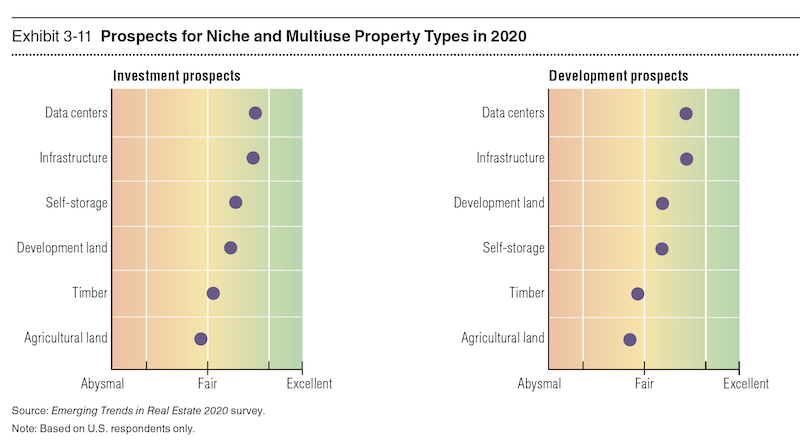
Data centers and infrastructure are two building types where experts foresee better than average growth prospects.
Many of these trends are premised on economic assumptions that ULI lays out in its Real Estate Economic Forecast. It expects the U.S. gross domestic product to increase by 2.3% this year 1.7% next year, and 1.9% in 2021. Net job growth should average 1.7 million per year through 2021. Yields on 10-year U.S. Treasury notes are expected to decline, which ULI states “should be a positive for real estate values.”
Real estate transaction volumes are expected to moderate over the forecast period, from a projected $475 billion this year to $415 billion in 2021. Real estate price growth is also expected to slow, from 5.1% this year to 3.9% in 2021.
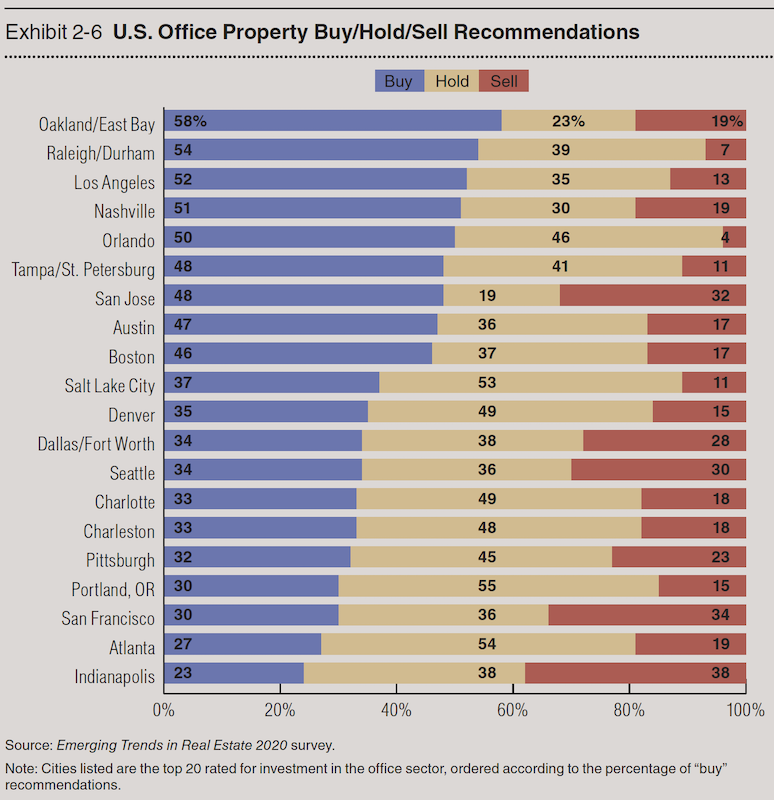
The Oakland, Calif., market remains ripe for office development and construction.
Rent growth should be flat for all building types except industrial and hotels, which will see declines. National vacancy rates will rise slightly, predicts economists.
Total real estate returns, as well as equity real estate investment trust returns, are expected to be strong over the next two years. On the flip side, increasing construction costs are tamping down single-family housing, to the point where ULI’s report is forecasting an annual average, through 2021, of between 800,000 and 850,000 units delivered, well below the long-term annual average of 975,000. Home prices, though, should continue to average 3.2% growth per year over the forecast period.
Related Stories
K-12 Schools | Mar 18, 2024
New study shows connections between K-12 school modernizations, improved test scores, graduation rates
Conducted by Drexel University in conjunction with Perkins Eastman, the research study reveals K-12 school modernizations significantly impact key educational indicators, including test scores, graduation rates, and enrollment over time.
MFPRO+ News | Mar 16, 2024
Multifamily rents stable heading into spring 2024
National asking multifamily rents posted their first increase in over seven months in February. The average U.S. asking rent rose $1 to $1,713 in February 2024, up 0.6% year-over-year.
Market Data | Mar 14, 2024
Download BD+C's March 2024 Market Intelligence Report
U.S. construction spending on buildings-related work rose 1.4% in January, but project teams continue to face headwinds related to inflation, interest rates, and supply chain issues, according to Building Design+Construction's March 2024 Market Intelligence Report (free PDF download).
Contractors | Mar 12, 2024
The average U.S. contractor has 8.1 months worth of construction work in the pipeline, as of February 2024
Associated Builders and Contractors reported that its Construction Backlog Indicator declined to 8.1 months in February, according to an ABC member survey conducted Feb. 20 to March 5. The reading is down 1.1 months from February 2023.
Market Data | Mar 6, 2024
Nonresidential construction spending slips 0.4% in January
National nonresidential construction spending decreased 0.4% in January, according to an Associated Builders and Contractors analysis of data published today by the U.S. Census Bureau. On a seasonally adjusted annualized basis, nonresidential spending totaled $1.190 trillion.
Multifamily Housing | Mar 4, 2024
Single-family rentals continue to grow in BTR communities
Single-family rentals are continuing to grow in built-to-rent communities. Both rent and occupancy growth have been strong in recent months while remaining a financially viable option for renters.
MFPRO+ News | Mar 2, 2024
Job gains boost Yardi Matrix National Rent Forecast for 2024
Multifamily asking rents broke the five-month streak of sequential average declines in January, rising 0.07 percent, shows a new special report from Yardi Matrix.
K-12 Schools | Feb 29, 2024
Average age of U.S. school buildings is just under 50 years
The average age of a main instructional school building in the United States is 49 years, according to a survey by the National Center for Education Statistics (NCES). About 38% of schools were built before 1970. Roughly half of the schools surveyed have undergone a major building renovation or addition.
MFPRO+ Research | Feb 27, 2024
Most competitive rental markets of early 2024
The U.S. rental market in early 2024 is moderately competitive, with apartments taking an average of 41 days to find tenants, according to the latest RentCafe Market Competitivity Report.
Construction Costs | Feb 22, 2024
K-12 school construction costs for 2024
Data from Gordian breaks down the average cost per square foot for four different types of K-12 school buildings (elementary schools, junior high schools, high schools, and vocational schools) across 10 U.S. cities.


